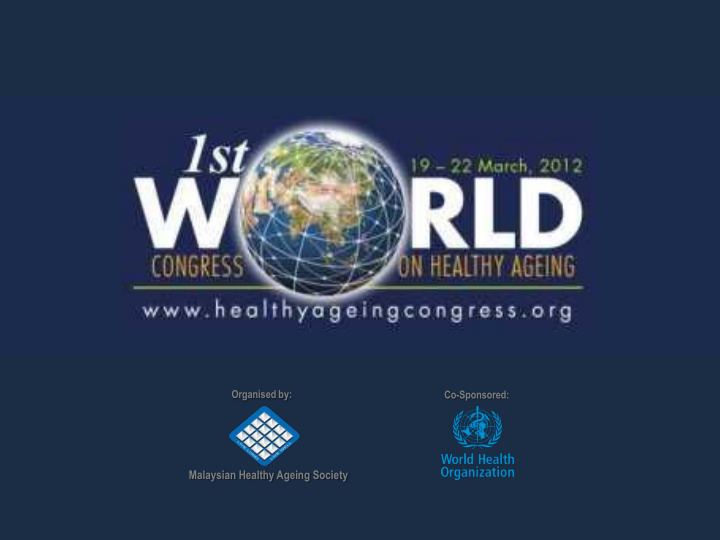



Organised by: Co-Sponsored: Malaysian Healthy Ageing Society
PHYSICAL ACTIVITY AMONG THE ELDERLY COMMUNITY DWELLERS IN A SUBURBAN DISTRICT IN SELANGOR Zaiton A, 1,2 Irmi Z, 1 Faezah H 1 1 Faculty of Medicine and Health Sciences UPM ,2 Institute of Gerontology UPM World Congress on Healthy Ageing 2012
Introduction • Physical activity (PA) is one of the important factors in the active ageing process (WHO,2002) • Exercise has been proven to have beneficial effects on both healthy and unwell older persons. (Young S.L 2003) • Regular PA reduced the risk of coronary artery disease ,diabetes , hypertension (Hajiwara A et al 2008) World Congress on Healthy Ageing 2012
Objective • The aim of this study was to evaluate the physically able older person on the types, barriers and their perception in carrying out their physical activities World Congress on Healthy Ageing 2012
Methodology • A survey was conducted among 230 older adults aged 60 years and above • Six out of eleven villages were included in a sub urban district in Selangor • Questionnaires consisted of socio- demographic and medical background, types of physical activities (leisure, sports, house work), social support, environment and perception towards PA World Congress on Healthy Ageing 2012
RESULTS AND DISCUSSION World Congress on Healthy Ageing 2012
Secondar y absent male Non-malay unmarried and above Malay married female primary present There was no significant relationship between physical activities and socio- demographic factors. World Congress on Healthy Ageing 2012
Types of Activity • In leisure activities Majority of the respondents walked mainly within their houses (89.1%), gardening (58.9%),cycling (15.6%), jogging (13.5%),climbing (16.1%) and weight lifting (9.9%). • 1 older adult played tennis • 75% respondents do household activities World Congress on Healthy Ageing 2012
-The main exercise among Malaysian adults was walking ( Poh BK, et al Mal J Nutr 2010 ) - Low intensity PA and walking was the exercise of choice among the elderly ( Akiko H. et al, 2008 ,Wong ML, 1998, Belza B, 2004 ) World Congress on Healthy Ageing 2012
Environmental Barriers to physical activities Environmental factors that hindered elderly from being physically active included weather; neighborhood safety ; fear of crime ; program costs; and inadequate availability , frequency, and reliability of affordable transportation ( Eyler AA, 1998 , Belza B, 2004 ). Environmental factors, like safe footpaths for walking and access to local facilities were associated with being active (Booth et al.,2001) World Congress on Healthy Ageing 2012 .
• Lack of motivation and social support were common barriers to PA ( Eyler AA, 1998, Belzar B, 2004) • Family encouragement significantly correlate to PA than friends (Wong ML, 1998). • Some of the elderly who live alone have had fewer opportunities to be encouraged by others .(Y. S. Lee, 2003) World Congress on Healthy Ageing 2012
Belief about benefits of exercise was positively correlated to PA (Wong ML, 1998) The attitude towards health benefits of PA was associated with physical activity participation. ( Booth et al,2001 ) Conversely, those who were physically active will have good perception about physical activity (Booth et al,2001) . World Congress on Healthy Ageing 2012
Conclusion • Walking was the most preferred choice of leisure PA • Unsafe environment and poor transportation were perceived as barriers to PA • However older adults were perceptive towards PA despite poor encouragement from their families, friends and health care provider • Hence there is a need for involvement not only from the community and health care agencies but more importantly the support from family members and peers. World Congress on Healthy Ageing 2012
References 1. Eyler AA, Baker E, Cromer L, King AC, Brownson RC, Donatelle RJ. Physical activity and minority women: a qualitative study. Health Educ Behav 1998;25(5):640-52 2. Belza B,,Walwick J, Shiu-Thornton S, Schwartz S, Taylor M, LoGerfo J. Older Adult Perspectives on Physical Activity and Exercise: Voices From Multiple Cultures. Prev Chronic Dis 2004; 1(4):1-16 3. Wong ML, Goh LG, Chia HP, Wee S, Hong CY. Correlates of leisure time physical activity in an elderly population in Singapore. Am J. Public Health 1999;89:1578-1580 4. Poh BK, Safiah MY, Tahir A, Siti Haslinda , Siti Norazlin , Norimah AK, Wan Manan , Mirnalini K, Zalilah MS, Azmi MY and Fatimah S. Physical Activity Pattern and Energy Expenditure of Malaysian Adults: Findings from the Malaysian Adult Nutrition Survey (MANS). Mal J Nutr2010; 16(1):13-37. 5. Booth ML, Owen N, Bauman A, Clavisi O, and Leslie E. Social – Cognitive and Perceived Environment Influences Associated with Physical Activity in Older Australians. Preventive Medicine 2000; 31:15 – 22 6. Lee SY., 2003. Factors Influencing Physical Activity among Older Adults with High Normal or Mild High Blood Pressure (Doctor of Philosophy’s thesis, University of Texas, Austin, United States of America). 7. Smith, V., Klein, K.J. & Ehrhart, M.G. Work Time, Work Interference with Family, and Psychological Distress. Journal of Applied Psychology 2002; 87(3): 427-436. World Congress on Healthy Ageing 2012
Recommend
More recommend